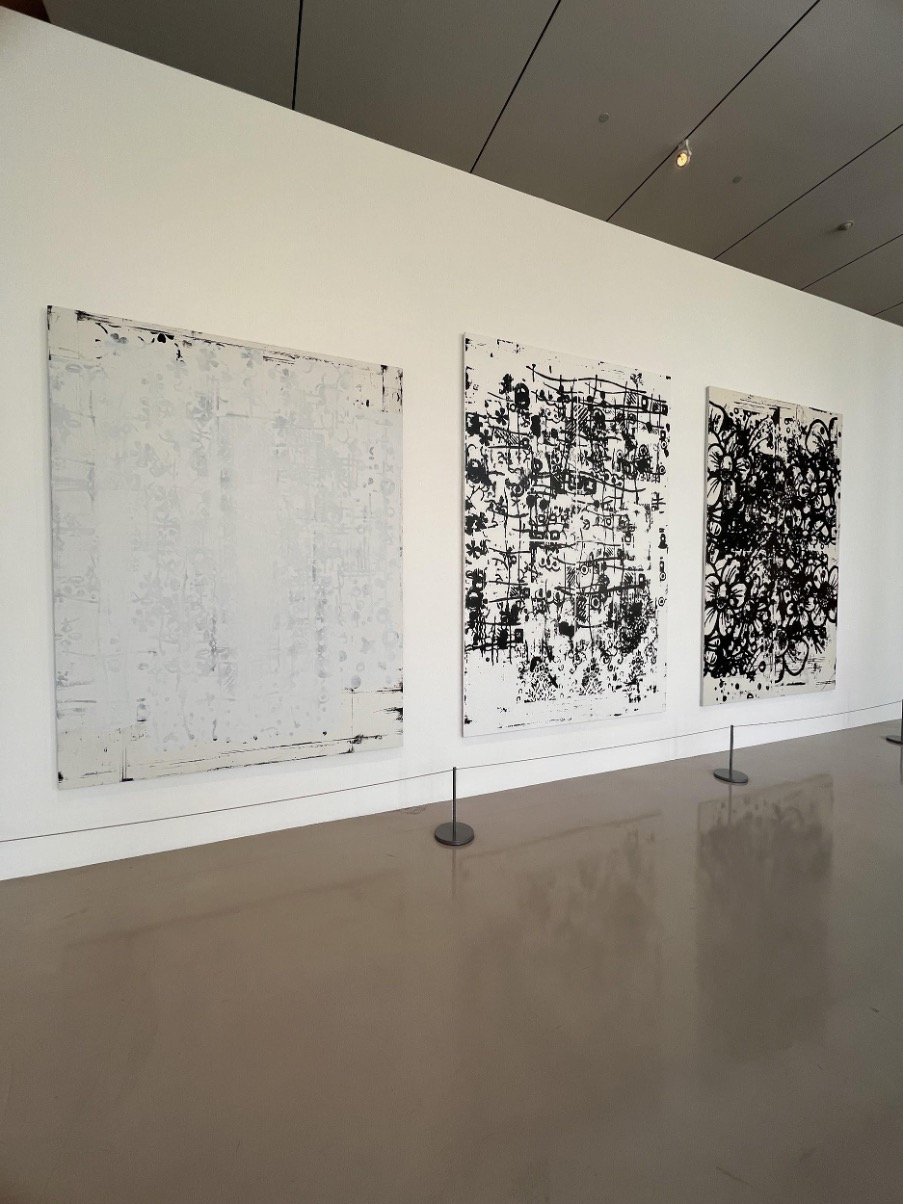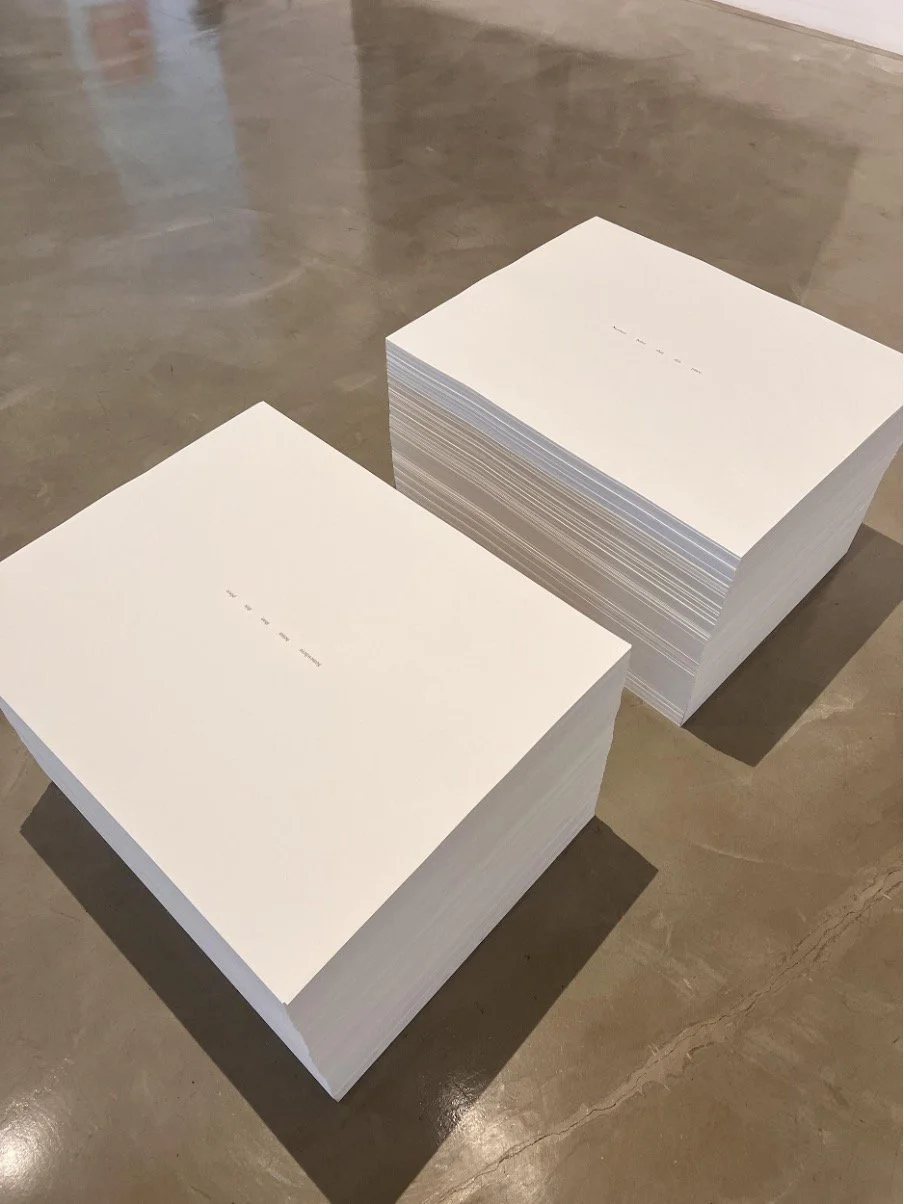‘There is Always One Direction’ @ The de la Cruz Collection in Miami
Located in the heart of Miami’s Design District, the de la Cruz Collection contains 30,000 square feet of exhibition space where the work rotates each year, freshly curated to consider the context of the contemporary and the ever-changing lens through which we look and reflect on artistic expression.
The 2021-2022 show entitled There is Always One Direction–taken from the title of a Gabriel Orozco sculpture on the top floor–brings together a number of unmistakable works including Félix Gonzalez-Torres lightbulbs, Glenn Ligon lettering, and black and white Christopher Wool motifs, as though the space were a temple and these works its columns.
Felix Gonzalez-Torres’ lightbulb work.
When entering the gallery space, a work that is not immediately recognisable stretches through its centre, which the knowledgeable, passionate docent explains is a documentary work by Cuban artist George Sanchez-Calderon. The artist’s images attempt to capture the scale and context of the exhibition that involved the recreation, in 80% scale, of Le Corbusier's masterpiece the Villa Savoye underneath Interstate 395 in downtown Miami, Florida in the wake of 9/11, reflecting on the resulting social, political, and economic implications of the process. The local perspective on a nationally significant event is elevated by the surrounding pillars of 20th-century art practice.
Christopher Wool canvases.
George Sanchez-Calderon, Reflexiones sober La Bendicion/Reflections on the Blessing, 2020.
The second floor is split up into smaller, more intimate side galleries that allow for more focused and nuanced curating. One corner features three utterly arresting works by Christina Quarles, a bisexual, biracial painter who explores notions of identity and self-expression. These canvases are flanked by an Alex Katz portrait of Hope Atherton–painter and wife of Gavin Brown–and three beautiful abstract works by Peter Doig, but Quarles holds her own against these masters. The twisting, contorted figures in distinctive colour palettes exude the emotion of personal discovery and arguably tell a far more intimate story than the more recognisable works by Katz and Doig.
Christina Quarles canvases.
Alex Katz canvases.
Peter Doig, Baked, 1990.
I spent a significant amount of time engaging with two of Kathryn Andrews’ works that were hung together–an aluminium, plexiglass, ink, and paint work from her Black Bars series entitled Dejeuner #1 (Girl with Napkin, Visor, Lemon, Lighter and Shuttlecock), featuring a slim view of a female face peering over the sculpture below, a metal arrangement of plates and poles with a motorcycle helmet atop entitled Charlie’s Angels. Playfully employing pop imagery and materiality, the female face peers at the viewer with no intention of revealing her own personal nature. Her gaze creeps over the reflective metal, reminding the viewer of their own presence and behaviours reflected in the slightly phallic, heavily industrial forms below. Both works work brilliantly together and confront challenging themes of industry, mass culture, and gender roles with great impact.
Kathryn Andrews, Black Bars: Dejeuner #1 (Girl with Napkin, Visor, Lemon, Lighter and Shuttlecock), 2016.
Kathryn Andrews, Charlie’s Angels, 2011.
The final floor far from fails to impress, with not only a candies work but also a paper work from Félix Gonzalez-Torres. A nearby display documents the correspondence that the artist kept with Rosa and Carlos de la Cruz–a particularly significant feature given his extraordinary ability to communicate through his work to which his letters and photographs added yet another layer of intimate detail.
Felix Gonzalez-Torres’ correspondence with Rosa and Carlos de la Cruz.
Felix Gonzalez Torres, Untitled, 1989-1990.
Felix Gonzalez-Torres, Untitled (Portrait of Dad), 1991.
The room is flanked with a quintessential Wilfredo Lam female form and a whole gallery dedicated to Ana Mendieta, but the Alex Isreal neon forms offer their own playful language dedicated to the visual stimulants of Los Angeles entertainment culture–an ambience well-suited to the Miami environment. Yet another way in which the emerging artists complete the context and provide a truly magnificent visual experience alongside the canonical icons of the collection.
Wilfredo Lam, Femme, 1942.
Ana Mendieta, Silueta Works in Mexico, 1973.
Alex Israel canvases.
In a mechanical crescendo, installed on the top floor is Gabriel Orozco’s 1994 work Four Bicycles (There is Always One Direction). Composed of four bicycle forms fused together in a tumbling web resembling an acrobatic performance, the lighting design casts shadows around the sculpture’s form, generating more circular shapes and sharp spokes that appear to expand the form itself as well as the dimension in which it operates. The object seems to move in many ways, but as a single purposeful unit, radiating pulsating energy as it orbits.
Gabriel Orozco, Four Bicycles (There is Always One Direction), 1994.
Orozco’s preoccupation with movement–in particular the ‘O’ form–and how something can move, rotate infinitely, and yet maintain a fixed and constant centre challenges one to reflect on why this work’s title inspired the overall title of the private collection’s annual exhibition. If the ruling ethos of the de la Cruz collection initiative fuses the renowned icons of global contemporary art with the fresh and innovative energy of emerging local talent–creating a powerful symbiosis which reveres the establishment and fosters the new–Four Bicycles explores the act of moving forward and the passing of time, furthering where we’re going and how we think. Created with a blend of many wheels, ideas, and perspectives, like the collection’s initiative, an explosion of progress is realised.
To visit or learn more about the de la Cruz Collection, click here. All photos by Kate Fensterstock.
Kate Fensterstock
Contributing Writer, MADE IN BED
















